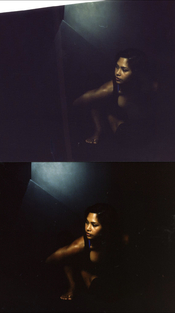It isn't.
CA, current version is II:
https://www.originalphotopaper.com/en/product/photographic-paper/ca/
Supreme:
https://www.originalphotopaper.com/en/product/photographic-paper/supreme/
Supreme HD:
https://www.originalphotopaper.com/en/product/photographic-paper/supreme-hd/
Datasheet to be downloaded from each product page. They're different products. Anyone who has ever physically handled CAII and Supreme would know as they're coated onto a different base to begin with, and they're different emulsions as well.
It looks to me like a rather exaggerated digital representation of what you get in chemistry that works OK for other papers, including Fuji papers. The nature of the blacks really depend a lot on how you digitize something and particularly what kind of corrections are applied. To put it differently: the dmax of RA4 paper is always less than the densities that modern scanners easily resolve detail in, which means you can make any RA4 black look mottled if you scan into the shadows deeply enough. My comment of recognition pertained to the hue of the CAii blacks (which leans towards purple/brown) and their uneven nature (mottled); particularly the former is apparent in your digital example.
That all papers I have used so far easily create a deeper black than CAii and that CAii's blacks are unacceptable to me even in moderately bright indoor lighting (let alone outdoor/natural light) in the ways described above. Furthermore all RA4 papers I've printed on so far are not capable of achieving the kind of density that silver-based B&W paper does, but that this isn't a practical problem as it only translates into poor but irrelevant
transmissive dmax which of course for a printing paper is barely noteworthy; reflective dmax is usually good enough, perhaps with the exception of Kodak Royal which also has somewhat weak blacks, but still better than CAii. Finally I note that prints from a high-volume commercial photofinishing lab on the same paper that I got my hands on were even
worse in this respect than my own prints. If chemistry is the problem, then this commercial operation which processes more RA4 paper per day than I will likely do in my lifetime apparently is even less capable of keeping their developer functional than I am.
Well, yeah, but not in a literal sense. The weight of the base has nothing to do with it per se; it's really the emulsion. An interesting factoid is that Fuji's RA4 paper datasheets usually do not give absolute numbers on reflective dmax. At the same time, many of their datasheets say things like "improved blacks" - which is kind of sour because if you compare CAii to the original Crystal Archive, both the base of the old product was heavier and more importantly the dmax was miles better than what CAii does today.
Trust me, I've tried just about everything to eliminate what I for months believed must have been user error on my behalf, but all I found was evidence that the culprit was really the paper itself.
Btw, CAii is fine as long as you don't print low-key images on it. Anything high-key, most of your holiday snapshots, etc. will look pretty much fine on it. But the kind of image you posted, that's where CAii really shows its shortcomings.
This problem has absolutely nothing to do with the negative used. Sure, low-contrast negatives necessitate reduced exposure to the point where dmax is reduced visibly. Of course I eliminated that scenario on day 1. Try it out; take a sheet of CAii, expose it to sufficient light to hit dmax and add another stop of light to that just to make sure. Process it, and then compare it to an identically processed print of any other paper. View under bright daylight conditions and observe the nature of the blacks. You'll see the problem, sure enough.











